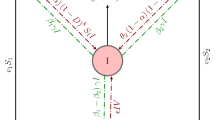Abstract
In this paper, we have considered an SIS epidemic model with arbitrary disease transmission function and arbitrary treatment control function. We have analyzed the model considering the disease transmission function as an increasing and decreasing function separately. To introduce heterogeneity in the system we have taken both the disease transmission function and treatment function as fuzzy numbers. Fuzzy expected value of the infected individual is defined and determined. Then fuzzy basic reproduction number is computed. At last, a threshold value is determined in both the cases where the system undergoes a transcritical and backward bifurcation.







Similar content being viewed by others
References
Kar, T.K., Jana, S.: A theoretical study on mathematical modelling of an infectious disease with application of optimal control. BioSystems 111(1), 37–50 (2013)
Zhang, X., Liu, X.: Bifurcation of an epidemic model with saturated treatment. J. Math. Anal. Appl. 348(1), 433–443 (2008)
Adak, S., Jana, S.: A study on stegomyia indices in dengue control: a fuzzy approach. Soft Comput. 25(1), 699–709 (2021)
Jana, S., Haldar, P., Kar, T.K.: Optimal control and stability analysis of an epidemic model with population dispersal. Chaos Solitons Fractals 83, 67–81 (2016)
Kar, T.K., Jana, S.: Application of three controls optimally in vector borne disease- A mathematical study. Commun. Nonlinear Sci. Numer. Simul. 18(10), 2868–2884 (2013)
Wang, W., Ruan, S.: Bifurcations in an epidemic model with constant removal rate of the infectives. J. Math. Anal. Appl. 291(2), 433–444 (2004)
Kar, T.K., Mondal, P.K.: Global dynamics of a tuberculosis epidemic model and the influence of backward bifurcation. J. Math. Model. Algorithms 11(4), 433–459 (2012)
Cao, X., Jin, Z.: Epidemic threshold and ergodicity of an SIS model in switched networks. J. Math. Anal. Appl. 479(1), 1182–1194 (2018)
Murray, J.D.: Mathmatical Biology, 3rd edn. Springer, Berlin (2002)
Kermack, W.O., McKendric, A.G.: Contribution to the mathematical theory of epidemics. Proc. R. Soc. London Series A 115(772), 700–721 (1927)
Kar, T.K., Jana, S., Ghorai, A.: Effect of isolation in an infectious disease. Int. J. Ecol. Econ. Stat. 29(2), 87–106 (2013)
Arino, J., Cooke, K.L., Driessche, P., Valesco-Hernandez, J.: An epidemiology model that includes a leaky vaccine with a general waning function. J. Differ. Equ. 4(2), 479–495 (2004)
Makinde, O.D.: A domain decomposition approach to a SIR epidemic model with constant vaccination strategy. Appl. Math. Comput. 184(2), 842–848 (2007)
Thomasey, D.H., Martcheva, M.: Serotype replacement of vertically transmitted disease through perfect vaccination. J. Biol. Syst. 16(2), 255–277 (2008)
Gumel, A.B., Moghadas, S.M.: A qualitative study of vaccination model with nonlinear incidence. Appl. Math. Comput. 143(2–3), 409–419 (2003)
Qiu, Z., Feng, Z.: Transmission dynamics of an influenza model with vaccination and antiviral treatment. Bull. Math. Biol. 72(1), 1–33 (2013)
Hu, Z., Ma, W., Ruan, S.: Analysis of SIR epidemic models with nonlinear incidence rate and treatment. Math. Biosci. 238(1), 12–20 (2012)
Zhou, L., Fan, M.: Dynamics of an SIR epidemic model with limited resources visited. Nonlinear Anal. Real World Appl. 13(1), 312–324 (2012)
Brauer, F.: Backward bifurcation in simple vaccination treatment models. J. Biol. Dyn. 5(5), 1–9 (2011)
Okosun, K., Ouifki, R., Marcus, N.: Optimal control analysis of a malaria disease transmission model that includes treatment and vaccination with waning immunity. Biosystems 106(2–3), 1–28 (2011)
Laarabi, H., Abta, A., Hattaf, K.: Optimal control of a delayed SIRS epidemic model with vaccination and treatment. Acta Biotheoretica 63(2), 87–97 (2015)
Hethcote, H.W.: The mathematics of infectious disease. SIAM Rev. 42(4), 599–653 (2000)
Capasso, V., Serio, G.: A generalization of the Kermack-Mackendric deterministic epidemic model. Math. Biosci. 42(1–2), 43–61 (1978)
Ruan, S., Wang, W.: Dynamical behavior of an epidemic model with a nonlinear incidence rate. J. Differ. Equ. 188(1), 135–163 (2003)
Liu, W.M., Levin, S.A., Iwasa, Y.: Influence of nonlinear incidence rates upon the behavior of SIRS epidemiological models. J. Math. Biol. 23(2), 187–204 (1986)
Eckalbar, J.C., Eckalbar, W.L.: Dynamics of an epidemic model with quadratic treatment. Nonlinear Anal. Real World Appl. 12(1), 320–332 (2011)
Zhou, Y., Yang, K., Zhou, K., Liang, Y.: Optimal vaccination policies for an SIR model with limited resources. Acta Biotheoretica 62, 171–181 (2014)
Zadeh, L.A.: Fuzzy sets as a basis for theory of possibility. Fuzzy Sets Syst. 1(1), 3–28 (1978)
Massad, E., Ortega, N.R.S., Barros, L.C.D., Struchiner, C.S.: Fuzzy Logic in Action: Application of Epidemiology and Beyond, 1st edn. Springer, Berlin (2008)
Mishra, B.K., Pandey, M.K.: Fuzzy epidemic model for the transmission of worms in a computer network. Nonlinear Anal. 11(5), 4335–4341 (2010)
Mondal, P.K., Jana, S., Haldar, P., Kar, T.K.: Dynamical behavior of an epidemic model in a fuzzy transmission. Int. J. Uncertain Fuzziness Knowl. Based Syst. 23(5), 651–665 (2015)
Acknowledgements
The work of Soovoojeet Jana is financially supported by Dept of Science & Technology and Biotechnology, Govt. of West Bengal (vide memo no. 201 (Sanc.)/ST/P/S&T/16G-12/2018 dt 19-02-2019). Moreover, the authors are very much thankful to the anonymous reviewers and Chin-Hong Park, the editor in chief of the journal, for their constructive comments and helpful suggestions to improve both the quality and presentation of the manuscript significantly.
Author information
Authors and Affiliations
Corresponding author
Additional information
Publisher's Note
Springer Nature remains neutral with regard to jurisdictional claims in published maps and institutional affiliations.
Rights and permissions
About this article
Cite this article
Adak, S., Jana, S. Dynamical behavior of an epidemic model with fuzzy transmission and fuzzy treatment control. J. Appl. Math. Comput. 68, 1929–1948 (2022). https://doi.org/10.1007/s12190-021-01597-8
Received:
Revised:
Accepted:
Published:
Issue Date:
DOI: https://doi.org/10.1007/s12190-021-01597-8




